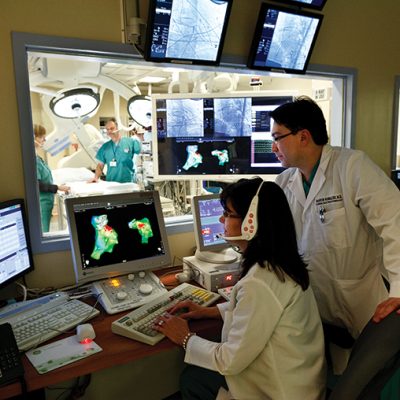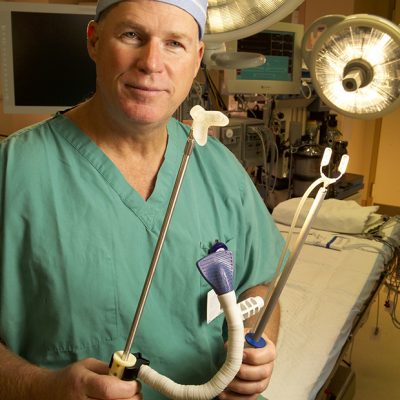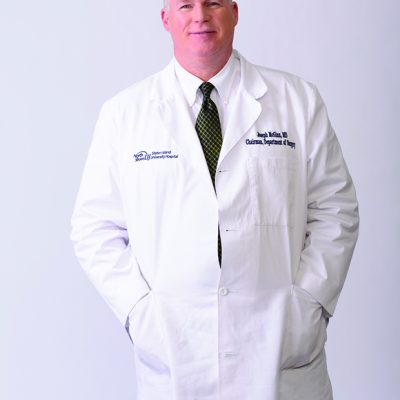
A groundbreaking, complication-reducing bypass procedure, courtesy of SIUH’s heart institute co-founder
After years of practicing and studying cardiothoracic surgery, Dr. Joseph McGinn discovered nothing less than a way to simplify the highly invasive traditional bypass procedure.
“I was continually researching and looking for a palatable format for minimally invasive heart surgery, because with all of the advances in medicine and surgical procedure, I knew there had to be a way to reduce the ordeal of such a major technique,” Dr. McGinn explained. “Thereby shortening the recovery phase and limiting post surgery complications. So, in 2005, we started working with cadavers, studying ways to get to the heart using a very small incision in between the ribs on the left hand side.”
The result was the McGinn Technique, a revolutionary bypass surgery that is performed through three small incisions, and pioneered by the doctor and his staff at Staten Island University Hospital’s Heart Institute. Since its inception, the method has properly addressed and corrected issues of stabilization that had plagued bypass procedure progress for decades, and it has been a lifeline for thousands of patients in the tri-state area and beyond.
“We applied suction cups to the heart, so that we were able to move it around and dial into the arteries that needed to be bypassed,” noted McGinn, the medical director of the Heart Institute. “Once we get into the artery, we needed to hold it still, so we created a cardiac stabilizer.”
The technique sounds simple on paper, McGinn added, but because it involves an unstable muscle like the heart, the process is in fact very challenging.
“These types of laparoscopic procedures first started with the gall bladder, using cameras and monitors to guide the technique,” said McGinn. “But the gall bladder is perfectly still. The heart is constantly beating and moving, of course, and trying to plot the movement of the heart and lungs is chaotic.”
McGinn worked with a Minnesota-based company called Medtronic to produce and miniaturize stabilizers that would resolve those issues during surgery. As a result, and since 2005, he has performed almost 1,000 of the procedures (more than 200 per year currently) and trained better than 200 doctors to do the same.
“Doctors from all over the country and the world visit here frequently for training sessions,” the surgeon said. “We routinely work with teams from China, Japan, and beyond.”
It’s just one of the innovative methods that the Heart Institute is employing.
“No one else in the city is doing what we’re doing here,” McGinn said. “Every day within the five boroughs, there are at least 20 to 25 patients who unnecessarily have their chest opened the old fashioned way, which requires a three-month healing process, a large sternotomy incision, and broken ribs or breastbone. We’re bringing a groundbreaking practice to a population that needs and deserves it.”
McGinn, who received his medical degree from the State University of New York Health Science Center in Brooklyn, completed a general surgery residency at SUNY Downstate (also Brooklyn), followed by a Cardiothoracic Surgery fellowship at Long Island Jewish Medical Center in New Hyde Park, NY. He is triple board certified in General Surgery, Thoracic Surgery, and Surgical Critical Care, and is one of the founders of The Heart Institute, which was developed in 2001. His technique put both the doctor and the community he serves on the world’s cardiothoracic map.
Good candidates for the surgery include patients who have been diagnosed with coronary artery disease, those who have had previously unsuccessful stenting, and those with severe symptoms that can no longer be controlled with medication or angioplasty. The surgery may also be beneficial to individuals with co-morbidities such as advanced age, long-term steroid use, severe coronary obstructive pulmonary disease, severe reconditioning, or with arthritic or orthopedic problems.
There are patients, however, with conditions that make the McGinn Technique inadvisable, including those with hemodynamic instability, posterolateral branch disease, and morbid obesity, but for those who qualify, the doctor detailed additional benefits.
“In this economy, people cannot afford to take off from work, so going back to the office a week after surgery, as opposed to three months, is a big plus,” he pointed out. “And in patients who are very sick and at high risk for traditional open heart surgery, it allows doctors to operate safely. On a regular basis, I am presented with patients who have been turned down elsewhere, and we are almost always able to perform the procedure—no matter what the roadblock might be.”
Other benefits include a safer recovery, since no bones are cracked, usually no pain medication required, and a reduced chance of pulmonary complications.
McGinn said that further advancements for the procedure are expected, including more modern connectors and a type of automated, stapler-like device which together will reduce the operation time by half.
“It’s still a very challenging procedure,” McGinn concluded. “Now we traditionally connect the bypass with magnifying glasses, very fine needles, and suture material, but in the next five to ten years, more breakthroughs will be developed. Right now we perform about 200 of these procedures annually, but we are always increasing our numbers. This is the future of cardiac surgery.”
The Heart Institute
718.226.6210 / theheartinstituteny.com







